The newest trend in technology for PTZ cameras is ‘PoE’ or power over ethernet. This technology allows for power to be carried over a Cat5e or Cat 6 cable. Today, ethernet cables can carry a substantial amount of data and power, and camera companies are working hard to take advantage of it. PoE was originally limited and only available for the CCTV camera market, but is now being included in many cameras for the AV and broadcast markets as well. Many HD PTZ cameras offer great resolution but it is harder to find cameras that both simplify your workflow and give you the best results. PoE technology eliminates the limitations of power cables and their installation.
In this article, we are going to do a camera review for two PTZ cameras that are looking to take PoE technology a step further, and also include HD video transmission over ethernet cable. These two cameras are the Datavideo PTC-150T and the Panasonic AW-HE40SK.
Both cameras are available at a $3,499 MSRP and have many similar specifications for image quality and optics. They have different approaches to look and style.
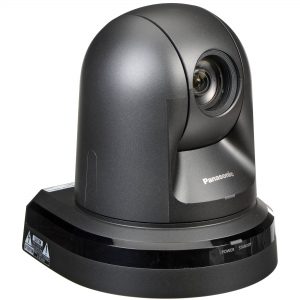
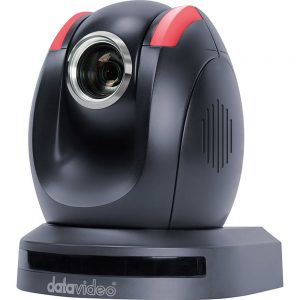
The AW-HE40SK is inherently lighter at 3.3lbs while the PTC-150T is at 6lbs.
We are going to put the cameras head to head in the following categories: Image quality and resolution, optics, production capability, and installation.
IMAGE QUALITY and RESOLUTION
WINNER: Datavideo PTC-150T
The image quality both cameras are able to deliver is nearly the same. The PTC-150T comes with a 1/2.8” progressive scan Sony CMOS sensor and the AW-HE40SK with a 1/2.3” Live MOS sensor(which is a more favorable marketing term for CMOS). The Panasonic has a slight edge in sensor size, but the minimum LUX is 0.35 compared to 0.4 LUX for the PTC-150T, with shutter speeds at 1/25 and 1/30 respectively, which is virtually the same. The main take away from all this is that the Panasonic camera is not taking advantage of its larger sensor for low light capability.
The Datavideo PTC-150T image quality can be seen in this camera overview video. Datavideo used PTC-150T cameras to shoot this video, giving you an idea of the confidence they have in their cameras. The camera is also based on the same video image quality specifications as the Datavideo PTC-150 HD PTZ Camera.
The image quality of the Panasonic AW-HE40SK can be seen in demo footage in this camera overview video.
While both cameras deliver similar quality, the PTC-150T takes the prize in this category for its superior image resolution and frame rate, delivering up to 1080p resolution at 60 frames per second. The Panasonic AW-HE40SK can only do up to 1080p at 30 frames per second. 1080p60 takes double the processing power as 1080p30. Many productions will enjoy being able to shoot at 1080p60 with the PTC-150T and not be limited.
OPTICS
TIE
When it comes to optics, the cameras could not be more similar. Both the Datavideo PTC-150T and Panasonic AW-HE40SL have a 30x zoom lens with an aperture of F1.6.
The focal length for the lens on both cameras is 4.3-129mm, the 35mm, Full Frame equivalent of which is 31.2mm – 962mm. Both cameras have very impressive zoom lenses for their size, the same lens, and are therefore in a tie for this category.
PRODUCTION CAPABILITY
Winner: Panasonic AW-HE40SK
The output connectors and features for video/audio output differs between these two cameras.
The PTC-150T has outputs for HDMI, HD-SD-SDI, and CVBS, which are all active at the same time. It will also transmit video over HDBaseT, as well as tally, control protocol, and power, to an included receiver box, which will then split the signal to output HDMI video to a video mixer, ethernet to the controller, and transmit power back to the camera.
The PTC-150T also features built in tally lights, which are good for many applications, and is something to consider when purchasing a camera. It also has 52mm threads for placing a lens cap, replacing the included UV filter, or adding ND filters when shooting in bright sunlight.
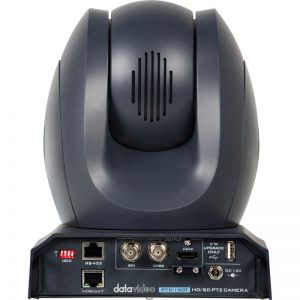
The Panasonic AW-HE40SK can output uncompressed video over HD-SDI. Panasonic also offers the camera in an HDMI configuration, but does not offer a camera of this type with both HDMI and HD-SDI outputs. It also supports a one cable workflow that transmits compressed IP video, audio, control and receives power over one CAT5e/CAT6 cable. The camera can also do HD-IP video output, output of video and audio via USB, and SD card recording.
The Panasonic AW-HE40SK lacks built in tally lights and filter threads, but has the ability to take an audio input from an external microphone and embed it with the video signal. It also has internal video recording over a micro SD card. Lastly, another big advantage is its ability to incorporate auto tracking software into its workflow.
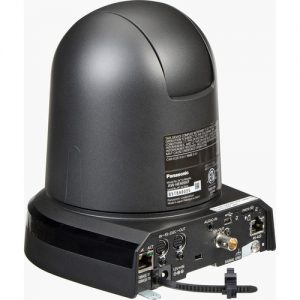
Both the AW-HE40SK and PTC-150T are able to do resolution for VGA and QVGA. A bit outdated but still very useful for some users. The PTC-150T can do SD over SD-SDI and composite video.
Both cameras have excellent production capabilities, and if you have a live production that doesn’t need embedded audio from a camera or a compressed back up recording from a camera, the PTC-150T would be a natural choice for its built in tally lights and filter threads. However in this category, the auto tracking software capability is a valuable addition for flexibility, giving better control to remote camera operators compared to traditional camera set ups. The audio input and embedding features, in addition to internal recording and video/audio output over HD-SDI and IP, give the Panasonic AW-HE40SK a slight edge for its flexibility in production applications.
INSTALLATION
Winner: Datavideo PTC-150T
For a live production setting, the PTC-150T is the only camera with a true one cable workflow from the camera station back to the video mixer and controller.
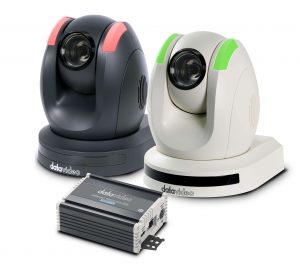
All this occurs with only one frame of delay. You can read more about the benefits of HDBaseT here. The Datavideo PTC-150T can be controlled by the Datavideo RMC-180 camera controller.
The Panasonic AW-HE40 can be operated with two cables, one transmitting uncompressed video, and the other transmitting and receiving control protocol and power over ethernet.
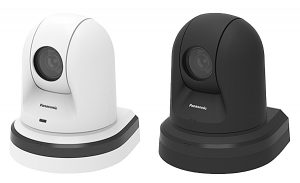
The one cable workflow for the Panasonic AW-HE40 is only over LAN and uses compressed video, which is not ideal for most applications. There is also a noticeable delay for IP video transmission on this camera, making it much less ideal for IMAG or in-house live screens than the Datavideo PTC-150T.
While the Panasonic AW-HE40SK comes PoE(power over ethernet) compatible, the Datavideo PTC-150T comes PoE ready and features HDBaseT. This new technology is making installation easier across multiple industries and Datavideo is one of the first camera companies to take advantage of it.
When it comes down to a winner, the Datavideo PTC-150T has accumulated more wins in categories during this camera comparison, but both cameras are taking different approaches to production workflows. It is important to account for the many features each one of these cameras have available.
Each camera has its own great qualities. The AW-HE40SK is simple, has audio input, and is designed to be connected over IP for multiple purposes. The PTC-150T is easier to set up and install with its HDBaseT Technology, offering power over ethernet and a one cable workflow right out of the box.
To learn more about the Datavideo PTC-150T click here.
To learn more about the Panasonic AW-HE40SK click here.
(Lucky Mig is the production company of Miguel Galindo, an independent director and producer.)
For any questions regarding this article, email TheLuckyMig@gmail.com

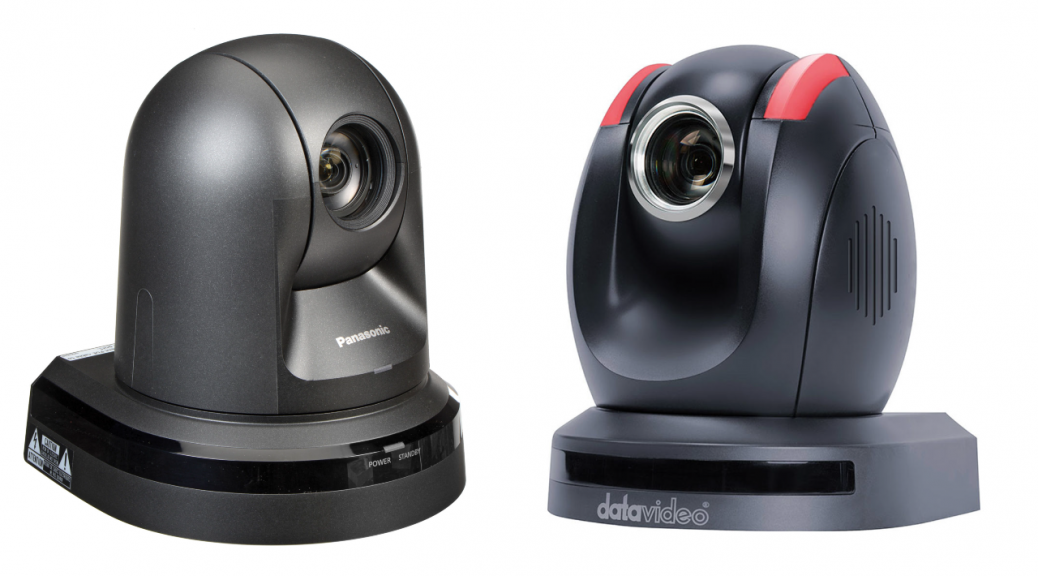
Thanks for sharing info. Keep up the good work.We hope you will visit our blog the newest trend in technology for PTZ cameras is ‘PoE’ or power over ethernet.often as we discuss topics of interest to youI would like to thank you for the efforts you have made in writing this article.